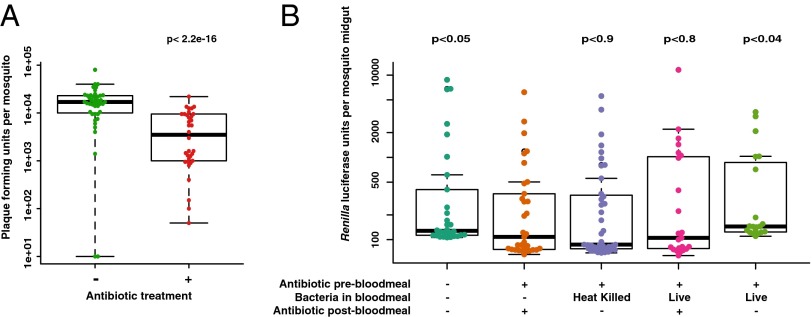Fig. 5.
Presence of live midgut bacterial flora is required for full viral infectivity of ONNV to An. gambiae. All mosquitoes that took a blood meal are represented in the figures. (A) Mosquitoes were orally treated from adult emergence with (+) or without (−) antibiotic for the duration of the experiment, and were challenged with virus by feeding an ONNV-infective blood meal. ONNV titers were assessed by plaque assay 3 d after the blood meal. Treatment with antibiotic reduced levels of bacterial flora greater than fivefold and strongly inhibited viral infectivity to mosquitoes. (B) Parameters of bacterial flora influence upon viral infection were dissected by the following treatment grid. Mosquitoes were orally treated (+) or not treated (−) with antibiotics before a blood meal (as indicated in the figure), and were infected orally by a blood meal containing ONN-RLuc. At 3 d postinfection, viral load was measured by RLuc quantitation in individual midguts. Bars 1 and 2 reproduce the nontreated and antibiotic-treated samples in A, but are shown here with viral quantitation by measurement of luciferase activity. For bar 3, the viral blood meal was supplemented with heat-killed culture of midgut bacteria, not followed by (−) antibiotic PBM. For bar 4, the viral blood meal was supplemented with live culture of midgut bacteria, but was followed by (+) antibiotic PBM. None of the treatments that eliminate live bacteria from the midgut restore virus infectivity to the mosquito. Only bar 5, which supplements the viral blood meal with live culture of midgut bacteria not followed by (−) antibiotic, complements the loss of viral infectivity caused by the initial antibiotic treatment. All P values were calculated using the second bar as the reference.

